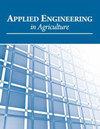育雏期和低温条件下禽舍热分层和氨浓度的同时降低
IF 0.8
4区 农林科学
Q4 AGRICULTURAL ENGINEERING
引用次数: 0
摘要
摘要:单尺度系统消除了热分层现象,全尺度系统降低了热分层现象;单尺度系统对氨的捕集效果中等,并适度降低了栏内氨的浓度;氨的捕集效果主要受粉尘积聚的影响;在畜棚排风机上游放置柠檬酸包覆粗麻布可减少氨和粉尘的排放。家禽育雏期间氨(NH3)浓度过高会降低禽类生产性能和福利。育雏期间的热分层会增加能量消耗,降低鸟类福利。一个概念验证的热回收和NH3控制(HRAC)系统由一个低成本的NH3过滤器组成,该过滤器由柠檬酸处理的粗麻布组成,放置在风扇的上游,以评估其降低谷仓NH3浓度和热分层的能力。在实验室中,5%的柠檬酸在粗麻布上捕获的NH3每单位质量比文献中报道的活性炭多13倍。笔级和谷仓级的HRAC原型在粗麻布上使用15%的柠檬酸,分别消除和大大减少了热分层。钢笔规模的HRAC在9个事件中的7个事件中具有显著的NH3去除效率,从17%到42%不等,与对照组钢笔(没有HRAC)相比,在9个事件中的2个事件中显著减少了26%和42%的地板[NH3]。笔级HRAC在15 d时也减少了足底皮炎。全尺寸HRAC的表现变化很大。颗粒物质堵塞过滤器会降低气流速率,使用振动筛可以部分减轻气流速率。带激振器的垂直HRAC可能会提高性能。有必要对5%柠檬酸的有效性进行研究。在谷仓排风机的上游放置柠檬酸处理的粗麻布筛网,可以减少粉尘和NH3的排放。关键词:突破曲线,粗麻布,柠檬酸,排放,能源利用,脚垫皮炎。本文章由计算机程序翻译,如有差异,请以英文原文为准。
Simultaneous Reduction of Thermal Stratification and Ammonia Concentrations in Poultry House During Brooding and in Cool Weather
HighlightsPen-scale system eliminated thermal stratification while full-scale system reduced thermal stratificationPen-scale system was moderately effective in trapping ammonia and reduced pen ammonia concentrations modestlyAmmonia trapping performance was mainly affected by dust build-upDust build-up was partly mitigated by a shakerCitric acid coated burlap placed upstream of livestock barn exhaust fans may reduce ammonia and dust emissionsAbstract. High ammonia (NH3) concentrations during poultry brooding can reduce bird performance and welfare. Thermal stratification during brooding can increase energy use and reduce bird welfare. A proof-of-concept heat recovery and NH3 control (HRAC) system consisting of a low-cost NH3 filter consisting of citric acid treated burlap placed upstream of a fan was evaluated for its ability to reduce barn NH3 concentration and thermal stratification. In the lab, 5% citric acid on burlap trapped 13 times more NH3 per unit mass of sorbent than activated carbon reported in the literature. Pen-scale and barn-scale HRAC prototypes using 15% citric acid on burlap eliminated and greatly reduced thermal stratification, respectively. The pen-scale HRAC had significant NH3 removal efficiencies ranging from the 17% to 42% in seven of nine events and compared, to the Control pens (no HRAC), significantly reduced floor [NH3] in two of nine events by 26% and 42%. The pen-scale HRAC also reduced footpad dermatitis at 15 d. Performance of the full-scale HRAC was highly variable. Clogging of the filter with particulate matter reduced airflow rates that was partially mitigated using a shaker. A vertical HRAC with a shaker might improve performance. There is need to investigate the effectiveness of 5% citric acid. The citric acid-treated burlap screen placed upstream of barn exhaust fans could reduce dust and NH3 emissions. Keywords: Breakthrough curve, Burlap, Citric acid, Emissions, Energy use, Footpad dermatitis.
求助全文
通过发布文献求助,成功后即可免费获取论文全文。
去求助
来源期刊

Applied Engineering in Agriculture
农林科学-农业工程
CiteScore
1.80
自引率
11.10%
发文量
69
审稿时长
6 months
期刊介绍:
This peer-reviewed journal publishes applications of engineering and technology research that address agricultural, food, and biological systems problems. Submissions must include results of practical experiences, tests, or trials presented in a manner and style that will allow easy adaptation by others; results of reviews or studies of installations or applications with substantially new or significant information not readily available in other refereed publications; or a description of successful methods of techniques of education, outreach, or technology transfer.
 求助内容:
求助内容: 应助结果提醒方式:
应助结果提醒方式:


